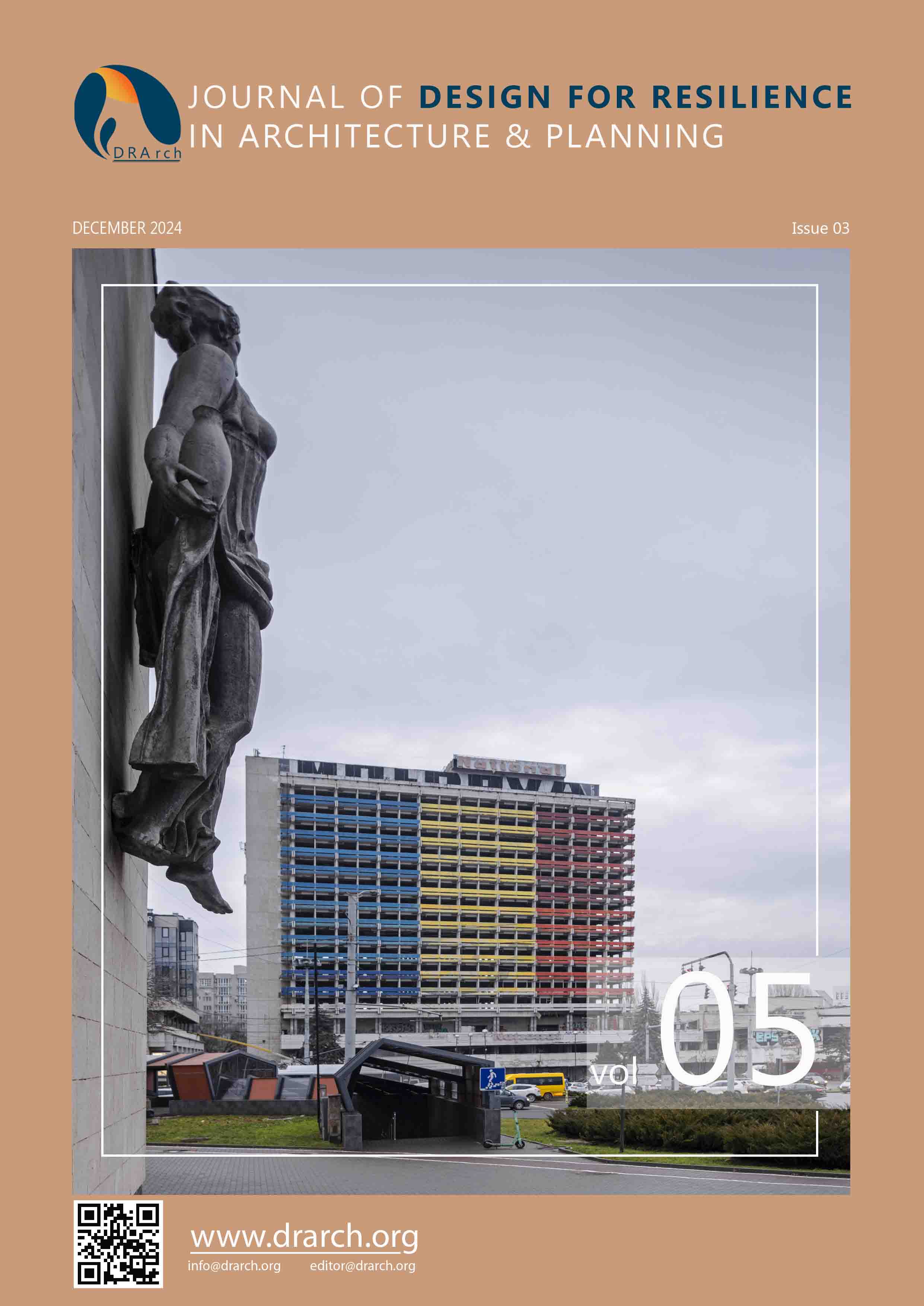Field study on determining the impact of design decisions on energy efficiency at settlement scale
DOI:
https://doi.org/10.47818/DRArch.2024.v5i3138Keywords:
artificial intelligence, autodesk forma, energy efficiency, settlement scaleAbstract
Urban settlement patterns are a major factor affecting regional energy consumption and are also one of the causes of energy consumption from buildings on a global scale. For this reason, it is an important and necessary approach to ensure energy efficiency in settlement and structural scales, especially in large-scale projects designed in dense urban fabric, considering the various effects they will cause. Within the scope of this study, the effects of buildings on their surroundings at the settlement and structural scales are analyzed through a group of buildings that contain many functions within the urban fabric and spread over a large area. It is planned to determine the effects of the buildings within the scope of a multi-unit project consisting of a total of 10 blocks in Sakarya Serdivan and opened in 2021, which is clearly separated from the surrounding settlement, on the dense residential, commercial and educational units around them, considering environmental factors in the context of energy efficiency. With this study, it is aimed to reveal the importance of the decisions taken at the design stages for sustainable settlement planning within the urban texture. For this purpose, firstly, a literature review was conducted on the contribution of decisions taken at the settlement and structural form scales in preventing/reducing energy consumption and energy efficient design criteria for the geographical location of the building group under consideration. In this direction, it is aimed to determine the compliance of the buildings in the existing design with these criteria and the effects of the buildings on the built environment at close scale and on the built environment with Autodesk Forma software, which can perform solar analysis, microclimate and comfort analysis with artificial intelligence support by enabling environmental analysis at these scales. Thus, the environmental impacts caused by the building group within itself and within the urban fabric and their relations with settlement geometries such as building layout types, building orientation and forms of buildings were evaluated.
Downloads
References
Bayraktar, M., Yılmaz, Z. (2007, October 25-28). Bina Enerji Tasarrufunda Pasif Akıllılığın Önemi, VIII. National Plumbing Engineering Congress, Izmir, Turkey.
Beygo, K., & Ali Yüzer, M. (2017). Early Energy Simulation of Urban Plans and Building Forms. A|Z ITU JOURNAL OF THE FACULTY OF ARCHITECTURE, 14(1), 13–23, Istanbul, Turkey. https://doi.org/10.5505/itujfa.2017.67689.
Erinç, S. (1996). Climatology and Methods (4. Edition), Alfa Press, İstanbul, Turkey.
Kısa Ovalı, P. (2009). Forming Ecological Design Criteria Systematics in terms of Climate Regions in Turkey: Kayaköy Settlement Sample, Trakya University, Institute of Science, Ph.D. Thesis (Thesis no. 244933), Edirne, Turkey.
Koca, Ö. (2006). An approach of determination of energy efficient settlement and Building Design Principles in Hot Dry and Hot Humid Regions, İstanbul Technical University, Institute of Science and Technology, Thesis (M.Sc.) (Thesis No. 172102), Istanbul, Turkey.
Kun, F. (2005). Evaluation of Tourism Purpose Buildings in terms of Cooling Load in the Scope of Climate Balanced Design: The Case of Kuşadası, Master Thesis (Thesis No. 168496), Yıldız Technical University, Institute of Science, Istanbul, Turkey.
Oke, T. R. (1988). Street Design and Urban Canopy Layer Climate. Energy and Buildings, 11(1-3), 103–113. https://doi.org/10.1016/0378-7788(88)90026-6.
Orhon, İ., Küçükdoğu, M. Ş. & Ok, V. (1988). Doğal İklimlendirme, Project Planning and Design Handbook for Housing Enterprise, TUBITAK, Publication No. U.9, Ankara, Turkey.
Stromann-Andersen, J., Sattrup, P. A. (2011). The Urban Canyon and Building Energy Use: Urban Density Versus Daylight and Passive Solar Gains. Energy and Buildings, 43(8), 2011-2020. https://doi.org/10.1016/j.enbuild.2011.04.007.
Umaroğulları, F., Cihangir, C. (2019). Evaluation of Mass Houses According to Climatic Comfort Design Parameters: ''Temperate Humid Climate Zone: Edirne Binevler (Part 1) Mass Housing Example'', Journal of Architecture and Life, 4(1), (105-122). https://doi.org/10.26835/my.661363.
UN-Habitat (2020). World cities report 2020: The Value of Sustainable Urbanization.
United Nations Department of Economic and Social Affairs, Population Division (2014). World urbanization prospects: The 2014 revision, highlights (ST/ESA/SER.A/352).
Wener, R., Carmalt, H. (2006). Environmental Psychology and Sustainability in High-rise Structures. Technology in Society, 28(1-2), 157-167. https://doi.org/10.1016/j.techsoc.2005.10.016.
Yılmaz, E., & Çiçek, İhsan. (2016). Thornthwaite climate classification of Turkey, Journal of Human Sciences, 13(3), 3973–3994. Retrieved from https://www.j-humansciences.com/ojs/index.php/IJHS/article/view/3994.
Yılmaz, Z., Koçlar Oral, G., Manioğlu, G. (2000). Determination of Thermal Insulation Value of Building Envelope Depending on Building Form in terms of Heating Energy Saving Executive: Prof. Dr. Zerrin Yılmaz, (Since September 1999, Assoc. Prof. Dr. Gül Koçlar Oral has been the coordinator of the research.) Institution: I. T. U. Faculty of Architecture, Supporting Institution: I. T. U. Research Fund (Project no. 985), (April 1998-January 2000).
Zeren, L. (1977). Climate-Balanced Architectural Practice in Turkey, Paper presented to TUBITAK VI. Science Congress, Izmir, Turkey.
Zeren, L. (1978). Solar Control in Architecture, ITU Publications, Istanbul.
Zeren, L. (1978). Architectural Built Environment Design and Solar Energy, Solar Energy and Environmental Design National Symposium, ITU Faculty of Architecture, Istanbul.
Zeren, L. (1987). A Study on Regulation Model Related to New Settlements and Buildings Energy Conservation in Turkey. Istanbul Technical University, Urban and Environmental Planning and Research Center, Istanbul, Turkey.
Zorer, G. (1992). Principles of Thermal Design in Buildings, YTU Faculty of Architecture Publications, University Publication No: 264, Faculty Publication No: MF-MIM 92.045, Istanbul, Turkey.
URL 1: Climate. (2024, April). In Wikipedia. https://tr.wikipedia.org/wiki/%C4%B0klim
URL2: Republic of Turkey Governorship of Sakarya, Serdivan. http://www.sakarya.gov.tr/serdivan
URL3: Serdivan Municipality, Geographical Area of Serdivan. https://serdivan.bel.tr/serdivan-in-cografi-alani
URL4: Weather Spark, Climate and Average Weather Year-Round in Serdivan. https://weatherspark.com/y/96519/Average-Weather-in-Serdivan-Turkey-Year-Round.
URL5: Day, M. (2023, June 5). Autodesk Forma: a deep dive into the data lake. https://aecmag.com/features/autodesk-forma-a-deep-dive-into-the-data-lake/#link
URL6: Autodesk Forma, Introduction to the sun hours analysis. https://help.autodeskforma.com/en/articles/6951253
URL7: Autodesk Forma, Introduction to daylight potential analysis. https://help.autodeskforma.com/en/articles/6951302
URL8: Autodesk Forma, Introduction to the wind analysis. https://help.autodeskforma.com/en/articles/6981020
URL9: Autodesk Forma, Introduction to the microclimate analysis. https://help.autodeskforma.com/en/articles/6932531
Downloads
Published
Issue
Section
License
Copyright (c) 2024 Ceren Aydan Nasır, Elif Özer Yüksel, Seher Güzelçoban Mayuk

This work is licensed under a Creative Commons Attribution 4.0 International License.








